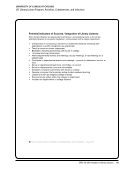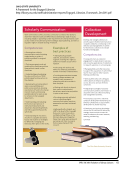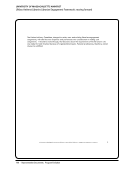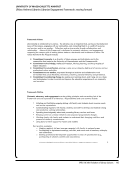72 · Survey Results: Survey Questions and Responses
Spending less time on reference desk
The addition of new areas of specialization, possibly paired liaisons for interdisciplinary work
The only shifting is fewer or no reference hours at the desks.
The subject experts will not be required to provide on-desk reference services. We are discussing how we support
digital scholarship.
There has been more automation of collection development. In 1999, the HSL implemented a single service point
and, gradually since then, librarians have focused their time on virtual service provision and outreach—a shift from
in-library-based physical service provision. Liaisons have also used online instruction, LibGuides, and other means of
meeting needs of larger groups. We have also expanded support staff roles to handle basic reference, and support of
bibliographic software and other basic services, that also enables librarians to spend more of their time on services and
roles that emerge.
They are no longer managing public service points. All public services/access services have been coordinated under
one department.
This is a continuously evolving situation. Currently, as the Libraries has begun to place more focus on scholarly
communication and its institutional repository this has become an added responsibility in conjunction with colleagues
from a newly formed office of scholarly communications. Over the last decade, emphasis on collection development
has diminished with the emergence of better approval plans and patron driven acquisition while focus on collection
assessment has increased.
Those liaisons who had heavy reference responsibilities have been shifting the work to GAs and appointment-based
rather than walk-up services.
We are likely to move away from enforced disciplinarity into a more flexible team-based approach in order to improve
outreach and service on new priorities and shift our areas of engagement.
We are moving towards a single service desk with more efficient staffing for reference as a way to focus liaisons’ work
in new areas. We are currently assessing other ways to shift responsibilities.
We have had some shifting of responsibilities and anticipate more, pending increases in funding/staffing. Some
collection management duties have been redistributed in order to allow the user engagement librarian to focus more on
outreach. Some have increased their work on general instruction in order to free others for more in-depth subject liaison
work. With more people, we could specialize more.
We play this by ear: each unit has different needs.
Yes, we closed our reference desk. We also assessed which workshops were actually needed and dropped others. But
the greatest factor in being able to add “functional” liaisons was getting additional positions, not relinquishing tasks.
LIAISON TRAINING
31. Do new liaisons receive training related to their new responsibilities? N=66
Yes 60 91%
No 6 9%
Spending less time on reference desk
The addition of new areas of specialization, possibly paired liaisons for interdisciplinary work
The only shifting is fewer or no reference hours at the desks.
The subject experts will not be required to provide on-desk reference services. We are discussing how we support
digital scholarship.
There has been more automation of collection development. In 1999, the HSL implemented a single service point
and, gradually since then, librarians have focused their time on virtual service provision and outreach—a shift from
in-library-based physical service provision. Liaisons have also used online instruction, LibGuides, and other means of
meeting needs of larger groups. We have also expanded support staff roles to handle basic reference, and support of
bibliographic software and other basic services, that also enables librarians to spend more of their time on services and
roles that emerge.
They are no longer managing public service points. All public services/access services have been coordinated under
one department.
This is a continuously evolving situation. Currently, as the Libraries has begun to place more focus on scholarly
communication and its institutional repository this has become an added responsibility in conjunction with colleagues
from a newly formed office of scholarly communications. Over the last decade, emphasis on collection development
has diminished with the emergence of better approval plans and patron driven acquisition while focus on collection
assessment has increased.
Those liaisons who had heavy reference responsibilities have been shifting the work to GAs and appointment-based
rather than walk-up services.
We are likely to move away from enforced disciplinarity into a more flexible team-based approach in order to improve
outreach and service on new priorities and shift our areas of engagement.
We are moving towards a single service desk with more efficient staffing for reference as a way to focus liaisons’ work
in new areas. We are currently assessing other ways to shift responsibilities.
We have had some shifting of responsibilities and anticipate more, pending increases in funding/staffing. Some
collection management duties have been redistributed in order to allow the user engagement librarian to focus more on
outreach. Some have increased their work on general instruction in order to free others for more in-depth subject liaison
work. With more people, we could specialize more.
We play this by ear: each unit has different needs.
Yes, we closed our reference desk. We also assessed which workshops were actually needed and dropped others. But
the greatest factor in being able to add “functional” liaisons was getting additional positions, not relinquishing tasks.
LIAISON TRAINING
31. Do new liaisons receive training related to their new responsibilities? N=66
Yes 60 91%
No 6 9%












































































































































































































